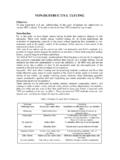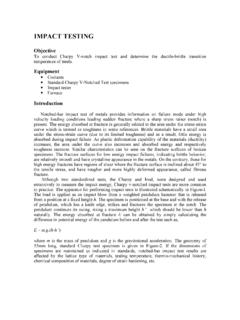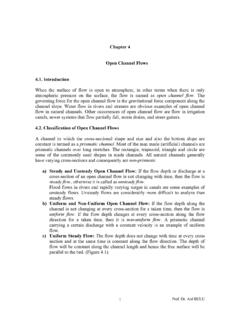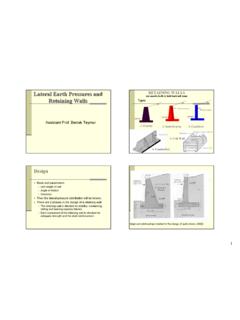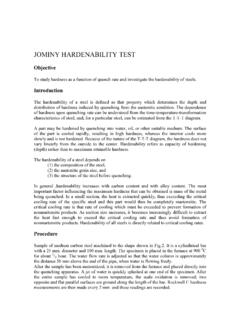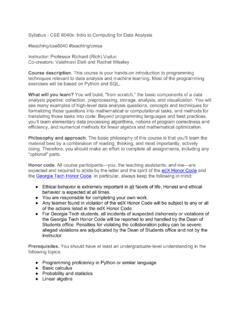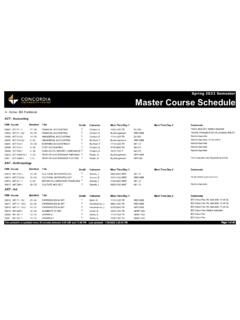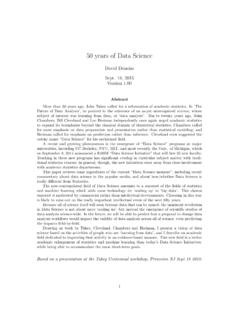Transcription of Cheat sheet Numpy Python copy - Anasayfa
1 2 Python For data Science Cheat SheetNumPy BasicsLearn Python for data Science Interactively at Python for data Science InteractivelyThe Numpy library is the core library for scientific computing in Python . It provides a high-performance multidimensional array object, and tools for working with these arrays. >>> import Numpy as npUse the following import convention:Creating Arrays>>> ((3,4)) Create an array of zeros>>> ((2,3,4),dtype= ) Create an array of ones>>> d = (10,25,5) Create an array of evenly spaced values (step value) >>> (0,2,9) Create an array of evenly spaced values (number of samples)>>> e = ((2,2),7) Create a constant array >>> f = (2) Create a 2X2 identity matrix>>> ((2,2)) Create an array with random values>>> ((3,2)) Create an empty arrayArray Mathematics>>> g = a - b Subtraction array([[ , 0.)]]
2 , 0. ], [-3. , -3. , -3. ]])>>> (a,b) Subtraction>>> b + a Addition array([[ , 4. , 6. ], [ 5. , 7. , 9. ]])>>> (b,a) Addition>>> a / b Division array([[ , 1. , 1. ], [ , , ]])>>> (a,b) Division>>> a * b Multiplication array([[ , 4. , 9. ], [ 4. , 10. , 18. ]])>>> (a,b) Multiplication>>> (b) Exponentiation>>> (b) Square root>>> (a) Print sines of an array>>> (b) Element-wise cosine >>> (a) Element-wise natural logarithm >>> (f) Dot product array([[ 7.
3 , 7.], [ 7., 7.]])Subsetting, Slicing, Indexing>>> () Array-wise sum>>> () Array-wise minimum value >>> (axis=0) Maximum value of an array row>>> (axis=1) Cumulative sum of the elements>>> () Mean>>> () Median>>> () Correlation coefficient>>> (b) Standard deviationComparison>>> a == b Element-wise comparison array([[False, True, True], [False, False, False]], dtype=bool)>>> a < 2 Element-wise comparison array([True, False, False], dtype=bool)>>> (a, b) Array-wise comparison1 231D array 2D array 3D 234 56 Array ManipulationNumPy Arraysaxis 0axis 1axis 0axis 1axis 2 Arithmetic Operations Transposing Array>>> i = (b) Permute array dimensions>>> Permute array dimensions Changing Array Shape>>> () Flatten the array>>> (3,-2) Reshape, but don t change data Adding/Removing Elements>>> ((2,6)) Return a new array with shape (2,6) >>> (h,g) Append items to an array>>> (a, 1, 5) Insert items in an array>>> (a,[1]) Delete items from an array Combining Arrays>>> ((a,d),axis=0) Concatenate arrays array([ 1, 2, 3, 10, 15, 20])>>> ((a,b)) Stack arrays vertically (row-wise)
4 Array([[ 1. , 2. , 3. ], [ , 2. , 3. ], [ 4. , 5. , 6. ]])>>> [e,f] Stack arrays vertically (row-wise)>>> ((e,f)) Stack arrays horizontally (column-wise) array([[ 7., 7., 1., 0.], [ 7., 7., 0., 1.]])>>> ((a,d)) Create stacked column-wise arrays array([[ 1, 10], [ 2, 15], [ 3, 20]])>>> [a,d] Create stacked column-wise arrays Splitting Arrays>>> (a,3) Split the array horizontally at the 3rd [array([1]),array([2]),array([3])] index>>> (c,2) Split the array vertically at the 2nd index[array([[[ , 2. , 1. ], [ 4. , 5. , 6. ]]]), array([[[ 3., 2., 3.], [ 4., 5., 6.]]])]Also see Lists Subsetting>>> a[2] Select the element at the 2nd index 3>>> b[1,2] Select the element at row 1 column 2 ( equivalent to b[1][2]) Slicing>>> a[0:2] Select items at index 0 and 1 array([1, 2])>>> b[0:2,1] Select items at rows 0 and 1 in column 1 array([ 2.)]
5 , 5.]) >>> b[:1] Select all items at row 0 array([[ , 2., 3.]]) (equivalent to b[0:1, :])>>> c[1,..] Same as [1,:,:] array([[[ 3., 2., 1.], [ 4., 5., 6.]]])>>> a[ : :-1] Reversed array a array([3, 2, 1]) Boolean Indexing>>> a[a<2] Select elements from a less than 2 array([1]) Fancy Indexing>>> b[[1, 0, 1, 0],[0, 1, 2, 0]] Select elements (1,0),(0,1),(1,2) and (0,0) array([ 4. , 2. , 6. , ]) >>> b[[1, 0, 1, 0]][:,[0,1,2,0]] Select a subset of the matrix s rows array([[ 4. ,5. , 6. , 4. ], and columns [ , 2. , 3. , ], [ 4. , 5. , 6. , 4. ], [ , 2. , 3. , ]])>>> a = ([1,2,3])>>> b = ([( ,2,3), (4,5,6)], dtype = float)>>> c = ([[( ,2,3), (4,5,6)], [(3,2,1), (4,5,6)]], dtype = float)Initial PlaceholdersAggregate Functions>>> (" ")>>> (" ", delimiter=',')>>> (" ", a, delimiter=" ") 56 Copying Arrays>>> h = () Create a view of the array with the same data >>> (a) Create a copy of the array>>> h = () Create a deep copy of the arraySaving & Loading Text FilesSaving & Loading On Disk>>> ('my_array', a)>>> (' ', a, b)>>> (' ')>>> Array dimensions>>> len(a) Length of array >>> Number of array dimensions >>> Number of array elements >>> data type of array elements>>> Name of data type >>> (int)
6 Convert an array to a different type Inspecting Your Array>>> ( )Asking For HelpSorting Arrays>>> () Sort an array>>> (axis=0) Sort the elements of an array's axisData Types>>> Signed 64-bit integer types >>> Standard double-precision floating point>>> Complex numbers represented by 128 floats>>> Boolean type storing TRUE and FALSE values>>> Python object type>>> Fixed-length string type>>> Fixed-length unicode 56123 FMAData Wranglingwith pandasCheat Creating DataFramesTidy data A foundation for wrangling in pandasIn a tidy data set:FMAEach variableis saved in its own column&Each observation is saved in its own rowTidy data complements pandas svectorizedoperations. pandas will automatically preserve observations as you manipulate variables.
7 No other format works as intuitively with data Change the layout of a data setMAF*MA* (df)Gather columns into (columns='var', values='val')Spread rows into ([df1,df2])Append rows of ([df1,df2], axis=1)Append columns of ('mpg')Order rows by values of a column (low to high). ('mpg',ascending=False)Order rows by values of a column (high to low). (columns = {'y':'year'})Rename the columns of a ()Sort the index of a ()Reset index of DataFrameto row numbers, moving index to (columns=['Length','Height'])Drop columns from DataFrameSubset Observations (Rows)Subset Variables (Columns)abc147102581136912df= ({"a" : [4 ,5, 6], "b" : [7, 8, 9], "c" : [10, 11, 12]}, index = [1, 2, 3])Specify values for each ([[4, 7, 10],[5, 8, 11],[6, 9, 12]], index=[1, 2, 3], columns=['a', 'b', 'c'])Specify values for each ({"a" : [4 ,5, 6], "b" : [7, 8, 9], "c" : [10, 11, 12]}, index = ([('d',1),('d',2),('e',2)],names=['n','v '])))Create DataFramewith a MultiIndexMethod ChainingMost pandas methods return a DataFrameso that another pandas method can be applied to the result.
8 This improves readability of ( (df).rename(columns={'variable' : 'var', 'value' : 'val'}).query('val>= 200'))df[ > 7]Extract rows that meet logical ()Remove duplicate rows (only considers columns). (n)Select first n (n)Select last n in Python (and pandas)<Less than!=Not equal to>Greater (values)Group membership== (obj)Is NaN<=Less than or (obj)Is not NaN>=Greater than or equals&,|,~,^, (), ()Logicaland, or, not, xor, any, Cheat sheet inspired by RstudioData wrangling Cheatsheet( ) Written by Irv Lustig, Princeton Consultantsdf[['width','length','species ']]Select multiple columns with specific ['width'] single column with specific (regex='regex')Select columns whose name matches regular expression [:,'x2':'x4']Select all columns between x2 and x4 (inclusive). [:,[1,2,5]]Select columns in positions 1, 2 and 5 (first column is 0).
9 [df['a'] > 10, ['a','c']]Select rows meeting logical condition, and only the specific columns .regex (Regular Expressions) Examples'\.'Matches strings containinga period '.''Length$'Matches strings ending with word 'Length''^Sepal'Matches strings beginning with the word 'Sepal''^x[1-5]$'Matches strings beginning with 'x' and ending with 1,2,3,4,5''^(?!Species$).*'Matches strings exceptthe string 'Species' (frac= )Randomly select fraction of rows. (n=10)Randomly select n [10:20]Select rows by (n, 'value')Select and order top n (n, 'value')Select and order bottom n DataMake New ColumnsCombine data Setsdf['w'].value_counts()Count number of rows with each unique value of variablelen(df)# of rows in ['w'].nunique()# of distinct values in a ()Basic descriptive statistics for each column (or GroupBy)pandas provides a large set of summary functionsthat operate on different kinds of pandas objects (DataFramecolumns, Series, GroupBy, Expanding and Rolling (see below)) and produce single values for each of the groups.
10 When applied to a DataFrame, the result is returned as a pandas Series for each column. Examples:sum()Sum values of each ()Count non-NA/null values of each ()Median value of each ([ , ])Quantiles of each (function)Apply functionto each ()Minimum value in each ()Maximum value in each ()Mean value of each ()Variance of each ()Standard deviation of each (Area=lambda df: * )Compute and append one or more new ['Volume'] = * * single ( , n, labels=False)Bin column into n functionVector functionpandas provides a large set of vector functions that operate on all columns of a DataFrameor a single selected column (a pandas Series). These functions produce vectors of values for each of the columns, or a single Series for the individual Series. Examples:shift(1)Copy with values shifted by (method='dense')Ranks with no (method='min')Ranks.
